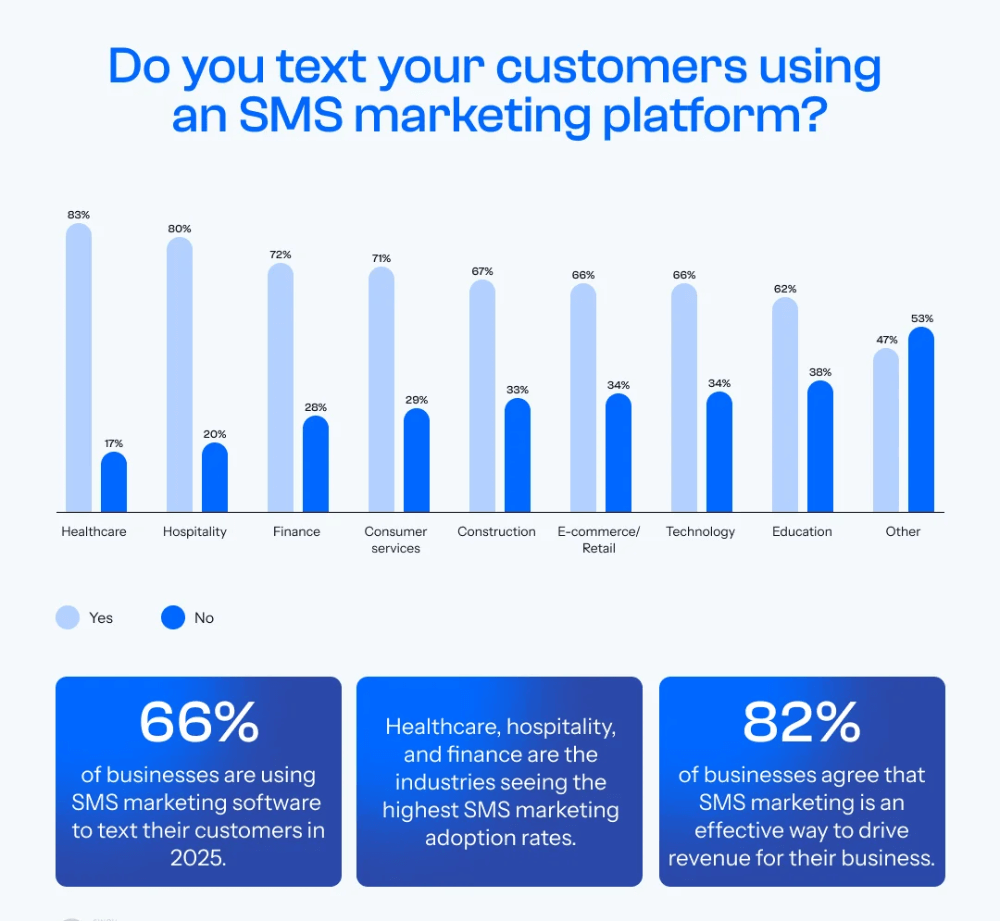📑Table of Contents:
Text messaging has become one of the most powerful marketing tools. In 2025, it continues to dominate as customers prefer fast, direct communication. Unlike email or social media, SMS goes straight to a person’s pocket. As a result, brands are seeing higher engagement, faster conversions, and stronger loyalty.
In this guide, we’ll explore the latest SMS statistics for 2025. You’ll see how numbers reveal important trends that every marketer must understand. From open rates to response times, these insights can shape smarter strategies.

Why SMS Marketing Keeps Growing
SMS has one advantage that few channels can match: attention. People read texts within minutes. They rarely ignore them. In contrast, emails often sit unopened. Push notifications can get disabled. But text messages feel personal and urgent.
Additionally, smartphone use keeps climbing. In 2025, over 7.4 billion mobile subscriptions exist worldwide. That means SMS offers unmatched reach. For businesses, this makes it an essential tool to connect with both global and local audiences.
Key SMS Statistics in 2025
Let’s look at the most important numbers shaping text message marketing this year.
1. Open Rates Stay Exceptionally High
Texts maintain an average open rate of 98%. Emails average about 20%. That gap proves why brands continue investing in SMS campaigns. When marketers want guaranteed visibility, text is the answer.
2. Response Time Remains Impressive
Customers reply to SMS messages in under 90 seconds on average. Compare that with email, where the response time is often measured in hours—or even days. This speed is crucial for time-sensitive offers, flash sales, or urgent alerts.
3. Opt-In Rates Are Rising
In 2025, about 65% of consumers opt in to receive branded text messages. That’s up from 54% just three years ago. The increase shows that people see value in SMS when it’s done right. They want updates, deals, and reminders sent directly to them.
4. Personalization Boosts Conversions
AI-powered personalization is driving results. Personalized texts deliver 30% higher conversion rates than generic blasts. Messages that use a customer’s name, past purchase data, or location get more clicks and more sales.
5. SMS Commerce Keeps Growing
The rise of text-to-pay and text-to-buy features is shaping commerce. By the end of 2025, analysts expect SMS-based transactions to generate over $50 billion globally. Customers enjoy the simplicity of buying directly from a text.
6. SMS Works Well With Other Channels
Omnichannel strategies perform best when SMS plays a role. Campaigns that combine email, push notifications, and SMS see 47% higher retention rates. Text messaging doesn’t replace other tools. Instead, it strengthens the entire communication mix.
7. Customer Preference Is Clear
Surveys reveal that 70% of consumers prefer businesses to contact them via SMS rather than phone calls. People value convenience. They want quick updates, not long conversations.
8. SMS Reduces Missed Appointments
In healthcare, finance, and service industries, SMS reminders cut no-shows by up to 40%. That saves money and improves customer satisfaction.
What These Numbers Mean for Marketers
Statistics tell a bigger story. Customers are comfortable with SMS, but only when messages respect their time and interests. The high open and response rates prove SMS is powerful. However, those numbers drop if businesses overuse the channel.
For example, personalization matters. People engage more when a text feels relevant. In contrast, sending the same generic promotion to everyone risks opt-outs.
Timing is another key factor. Messages sent at the right moment, such as before lunch for food promotions, get higher clicks. AI tools now help brands analyze behavior and predict the best time to send.
Future Trends to Watch
The numbers from 2025 highlight where SMS is headed next.
- AI integration: Expect smarter automation, from predictive message timing to advanced personalization.
- Richer messaging formats: RCS (Rich Communication Services) continues to grow. It allows multimedia, buttons, and interactive features.
- Global expansion: Emerging markets are seeing rapid SMS adoption, offering new opportunities for growth.
- Compliance focus: As regulations tighten, businesses must balance innovation with legal responsibility.
Best Practices for 2025 SMS Campaigns
To take advantage of these trends, marketers should follow proven strategies:
- Get clear consent – Always make sure customers opt in before sending.
- Use personalization – Tailor texts based on preferences, past behavior, and timing.
- Limit frequency – Don’t overwhelm customers with too many messages.
- Add value – Share offers, reminders, or alerts that genuinely help customers.
- Integrate with other channels – Combine SMS with email, social, and push for stronger results.
- Track results – Measure open rates, response times, and conversions to refine campaigns.

Final Thoughts
The statistics from 2025 show that SMS remains one of the strongest marketing channels. With nearly universal reach, unmatched open rates, and fast response times, it continues to deliver results that few other tools can achieve.
Yet, the key is balance. Customers want texts that are timely, relevant, and respectful. Brands that use data wisely, integrate SMS into broader strategies, and follow compliance rules will see the best outcomes.
SMS is no longer just a messaging tool. In 2025, it’s a transactional powerhouse, a loyalty driver, and a critical part of omnichannel marketing. The numbers prove it, and the future only looks stronger.
